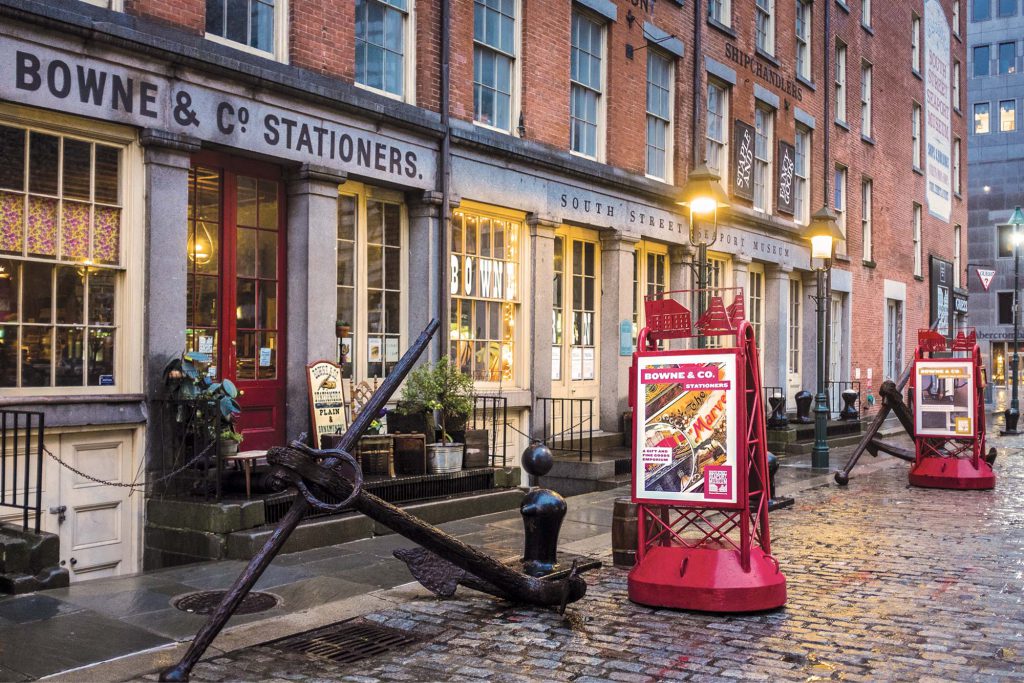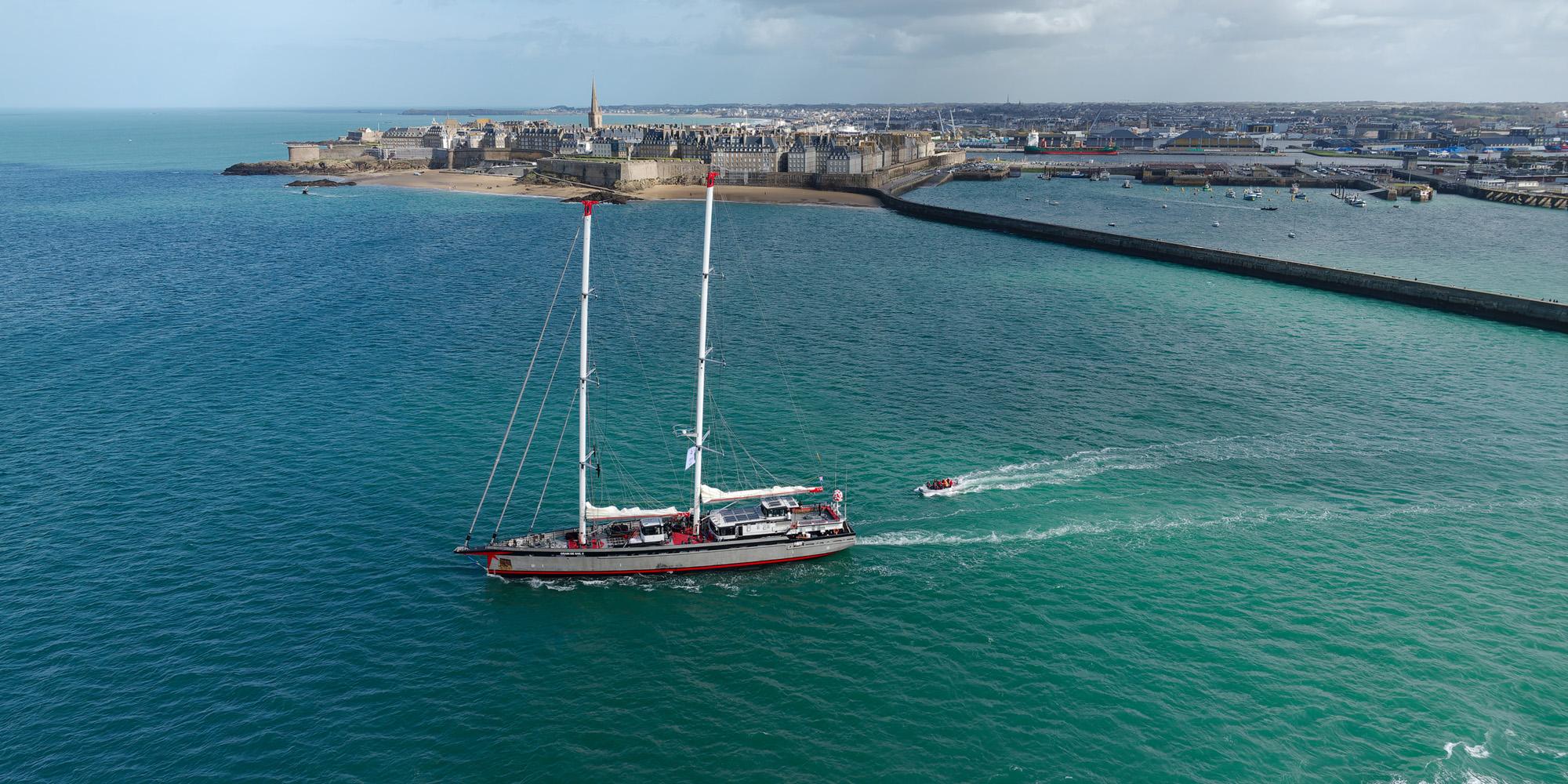December 4 | 6pm, 7pm | Wavertree and Pier 17, North Side | $15
Join the Seaport Museum and the schooner Grain de Sail for an engaging two-part tour that will showcase the past and present of transporting cargo under sail.
The tour will begin at Pier 16 aboard the 1885 tall ship Wavertree, to show how cargo was transported between ports in the 19th century. Join us to walk the length of the ship’s hold to grasp the immense scale and imagine the vast quantities of goods once transported under sail.
The tour will continue at Pier 17 aboard the first modern cargo schooner in the world to show how Grain de Sail offers a sustainable alternative to shipping organic goods internationally. See how the modernizations go beyond an aluminum hull to also include modern navigation technologies and a floating wine cellar that properly preserves bottles in ideal conditions throughout the voyage. As the world’s only commercial exporter of fine chocolates and wines by cargo sailboat, Grain de Sail takes on the responsibility of filling the limited space in the hull with the most deserving delicacies. This is your chance to see how!
The tour will conclude with a delightful glass of wine and a sampling of chocolates brought by Grain de Sail from France to New York, offering a taste of the voyage’s delectable cargo.
Space is limited. Advanced registration is encouraged for these tours but walkups will be accommodated as possible. Anyone ages 21 and up is welcome.
Seaport Museum members receive 20% off. Just sign in when prompted at checkout to receive your discount.
Please Note This is a Past Program, Event, or Activity
You are viewing an archived page for a program, event, or activity that has already taken place. In most cases these pages are no longer actively maintained and because of that may contain inaccurate or out-of-date information. These pages are left publicly viewable to preserve institutional memory and to allow the public to learn more about the types of programs, activities, and content created and made available by the South Street Seaport Museum throughout its history.
A Brief History of Sail Freight
For centuries, schooners carrying goods down the Hudson River from upstate docked at South Street Seaport, to distribute their cargo to local markets or to transfer their cargo onto ocean-bound ships to more distant destinations. This trade, and the industries it supported, from banking to warehousing to printing, helped make New York City into a global commercial and then cultural capital.
The history of sail freight dates back at least 500 years, while maritime trade has been in existence for more than 40,000 years. Despite significant shifts in the importance of inland and overseas navigation over recent centuries––especially with the rise of steam and fossil-fueled shipping and the railroads in the last 120–150 years––transportation by water remains vital to the world economy. The history of sail freight points to some possible points of departure for a future powered by sail.
Throughout history, water transportation has played a crucial role in shaping human societies and communities. Over thousands of years, people have built canals and altered rivers to expand the reach of ships and boats inland. Doing so reduced handling of goods, increased delivery speeds, and reduced the cost of shipping drastically, while greatly increasing the volume of goods moved.
Each region and time period developed unique vessels and rigging systems adapted to their level of technological sophistication, resource constraints, and maritime conditions. The pattern constantly evolved from adaptations, both local and global, spread by the normal course of cultural contact and technological diffusion.
In 1900, steam-propelled tonnage surpassed sailing-vessel tonnage in the United States. Before this date, sailing vessels had long dominated the world of commerce and trade. “The last report of the commissioner for navigation shows that the tonnage operating under our coasting laws is the largest in our history, and is greater than the coasting tonnage of any other nation. […] In the rest of the world steam tonnage eleven years ago exceeded sail tonnage.”
The last fleet of sailing vessels engaged in ocean trade ceased operation in 1948, though small networks do still exist. Today, sailing ships under wind power are highly efficient and proven sources of transportation of goods that the world could significantly use to reduce carbon emissions, provide jobs, and contribute to solving some issues of environmental justice. The re-adoption of this technology will go hand in hand with the infrastructure needed to support it, and labor requirement. The New York-based schooner Apollonia and the French sailing ship Grain the Sail are great examples of the revitalization of sail freight that harken back to earlier times.
About Grain de Sail
The adventure Grain de Sail was born in 2010 with a fleet in Morlaix, Brittany and a bold idea to go to the other side of the world in the most eco-friendly way to pick up chocolate and coffee using a cargo sailboat. Initially intended to bring back only cocoa and coffee from Latin America, Grain de Sail decided to include a stopover in New York, in order to limit empty trips. For her outward journey, she sails filled with goods entrusted to her by French companies also committed to decarbonization.
About the 1885 Tall Ship Wavertree
Wavertree was built at Southampton, England, in 1885 and, after a 24-year sailing career and circumnavigating the globe at least three times, is now the last remaining iron-hulled three-masted full-rigged cargo ship. Today, Wavertree serves as the iconic centerpiece of the bustling waterfront that shaped New York City into a modern metropolis.
Extend Your Visit
Access to the Seaport Museum’s 1885 tall ship Wavertree is included with your event ticket. Access to the 1908 lightship Ambrose and exhibition galleries is not included with this event. To explore more that the Museum has to offer, book in advance or ask Museum staff about Pay What You Wish admission tickets, available Wednesday through Sunday from 11am to 5pm when you check in.
Timed tours of the 1908 lightship Ambrose at Pier 16 are available separately.
Advance Pay What You Wish tickets for the forthcoming Maritime City exhibition, opening in March 2025 in A.A. Thomson & Co. located at 213 Water Street are now available. Be among the first to explore this exciting new exhibition!

Ready for more?
Head over to our Programs and Events page to see what else is happening at the Museum. Sign up for an upcoming talk, learn more about visiting Wavertree, or explore our virtual offerings.

